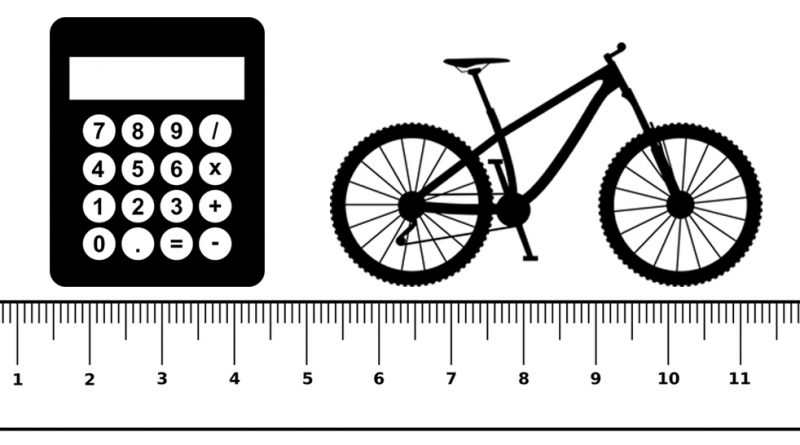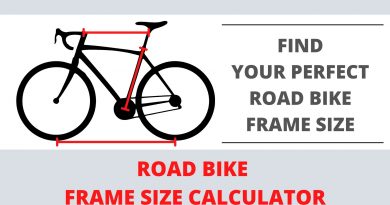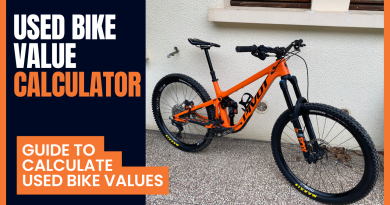Mountain Bike Frame Size Calculator, Charts, Fit & Frame Geometry
Your Ideal Frame Size Is:
How To Use The Mountain Bike Frame Size Calculator?
- Just add your height and select 'calculate'.
- The calculator will give you your recommended frame size in GREEN.
- If you are between sizes, the calculator will also show you the bigger or smaller frame size by percentage. (If you are more than 20% on either side, it's worth trying the other size too.)
Check out our road bike size calculator here
Check out our kid's bike size calculator here
READ MORE BELOW TO UNDERSTAND HOW TO SELECT THE PERFECT FRAME SIZE
NOTE: Our mountain bike frame size calculator has been designed to make frame size selection as easy as possible, but it's only an estimate (as there are many factors to consider). We have chosen to do our mountain bike frame size calculator by riders height, due to the fact the majority of people have an average limb proportion in relation to their height. However, some people may have longer or shorter than average limbs which can affect frame size selection. It's also worth noting that mountain bike frame sizing varies considerably between brands, and types of mountain bikes.
Unless a mountain bike frame has been custom-made for you personally, there is always likely to be a slight compromise. Manufacturers select their frame size categories and make frames for average-sized people which fit into this predefined criteria. As people come in almost every different shape and size imaginable it's almost impossible for manufacturers to produce the perfect frame size for everyone. However, you can replace or adjust the bike's components to help tune your bike for the perfect fit. You can adjust things like; stem length, handlebar width, crank length, and saddle height/position.
What Size Mountain Bike Do I Need?
Finding the correct mountain bike frame size should be the first thing you consider when looking at a new bike. You want to pick a frame size that will allow you to feel at home on the bike. If the frame size is too small you will find it unstable and cramped, and if too big you will find the bike cumbersome and challenging in tight turns. Also, remember that most mountain bike frame sizes are fixed, and cannot be adjusted or altered, so it's important to make the right decision from the beginning.
The question is 'how do you select the correct mountain bike frame size?'. Keep on reading and we will take you through everything you need to know (as this simple question has a few factors to consider). For those of you that want a quick answer, we have created a mountain bike frame size calculator! However, it's recommended to read through to the end, so that you have a good understanding of everything you need to know for selecting the perfect frame size for you.
PLEASE NOTE: If you are an experienced rider coming from another cycling discipline, you should bear in mind that mountain bike sizing is notably different from most other types of bikes.
MTB Size Charts
Here is a generic sizing chart for mountain bike frames. Although this is a good starting point it is recommended to look at the size charts from the manufacturers of the bike you are interested in riding.
| Rider Height (in) | Rider Height (cm) | Frame Size | Frame Size (in) | Frame Size (cm) |
| 4' 10" - 5' 2" | 148cm - 158cm | XS | 13" - 14" | 33cm - 37cm |
| 5' 3" - 5' 6" | 159cm - 168cm | S | 15" - 16" | 38cm - 42cm |
| 5' 7" - 5' 10" | 169cm - 178cm | M | 17" - 18" | 43cm - 47cm |
| 5' 11" - 6' 1" | 179cm - 185cm | L | 19" - 20" | 48cm - 52cm |
| 6' 2" - 6' 4" | 186cm - 193cm | XL | 21" - 22" | 53cm - 57cm |
| 6' 4" + | 194cm + | XXL | 23" + | 58cm + |
Here are some links to the most popular mountain bike manufacturers sizing charts:
- Specialized - frame size chart
- Santa Cruz - frame size chart
- Giant Bicycles - frame size chart
- Trek - frame size chart
- Cannondale - frame size chart
- Kona - frame size chart
- Orbea- frame size chart
- Merida - frame size chart
- Orange bikes - frame size chart
- Scott - frame size chart
- Nukeproff - frame size chart
How Does MTB Sizing Work?
Most mountain bike brands size their bikes in XS (Extra Small), S (small), M (medium), L (large), XL (extra large), and some brands have XXS (double extra small), and XXL (double extra large).
Commonly the frame geometry numbers change with the size of the frame, apart from head angle, bottom bracket drop, and bottom bracket height - which often stays the same. Brands sometimes change the wheel size, suspension travel, dropper post length, and crank length depending on the frame size.
Historically bike brands used seat tube length to indicate frame size, however with modern bike design the seat tube length is becoming less of a factor. Most modern bike brands have realized that a low standover height is important to make a bike feel stable and corner well, however, this makes standover height less of a factor for frame sizing. Consequently, this is why bike brands have their own sizing metrics which are more based on rider height, and the average limb size correlating to that specific height.
Understanding MTB Geometry
Mountain bike geometry is the measurements and angles that make up the shape of a bike frame. These measurements determine how the frame will fit the rider and how the bike will perform for different disciplines. For example, the geometry of an XC mountain bike is very different from the geometry of a downhill mountain bike. In this section, we are going to introduce you to the key terms in mountain bike geometry and how they affect the fit and ride of a mountain bike.
NOTE: For more experienced riders it can be worth looking at the geometry table for a bike that fitted you well in the past and then look for a new bike with similar geometry numbers. Modern mountain bikes are getting longer, lower, and slacker which is great for racers looking to get down the hill the fastest, however, this trend is often not the most enjoyable geometry for the average mountain biker. Bikes that are built for speed are not always the most playful to ride.
- Reach
- Bottom Bracket Height
- Bottom Bracket Drop
- Wheelbase
- Seat tube Angle
- Chainstay Length
- Stack
- Head (Tube) Angle
Reach

The reach of a mountain bike is the horizontal measurement between the centre of the headtube and the bottom bracket. The reach of a mountain bike is one of the most important factors when considering frame sizing because it affects the bike's stability and the range of movement the rider has on the bike. A long reach is great for making the bike feel stable over rough trails, however, if the reach is too long it can make it hard to get your weight forward which will decrease front wheel grip in turns. If you are an experienced mountain biker looking to descend as fast as possible, then you may prefer to ride a bike with a longer reach. An average intermediate rider will probably benefit from riding a bike with a slightly shorter reach as it can be easier to pop up the front end and get your weight over the front in turns.
| AVERAGE REACH BY BIKE TYPE (MM) | S | M | L |
| XC BIKES | 415 | 445 | 470 |
| ENDURO BIKES | 426 | 453 | 472 |
| DH BIKES | 431 | 461 | 480 |
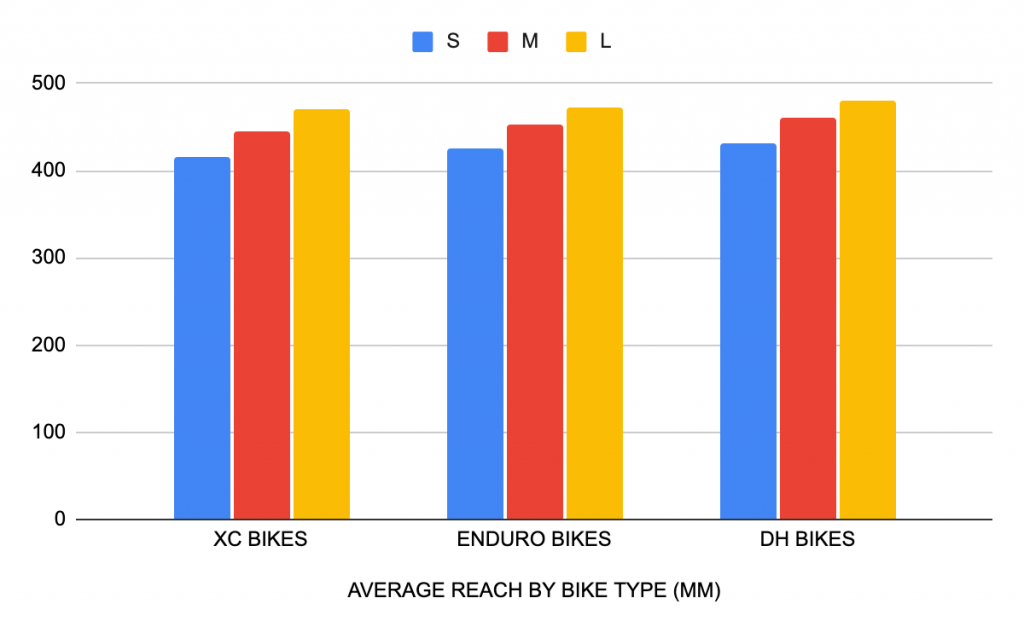
Bottom Bracket Height
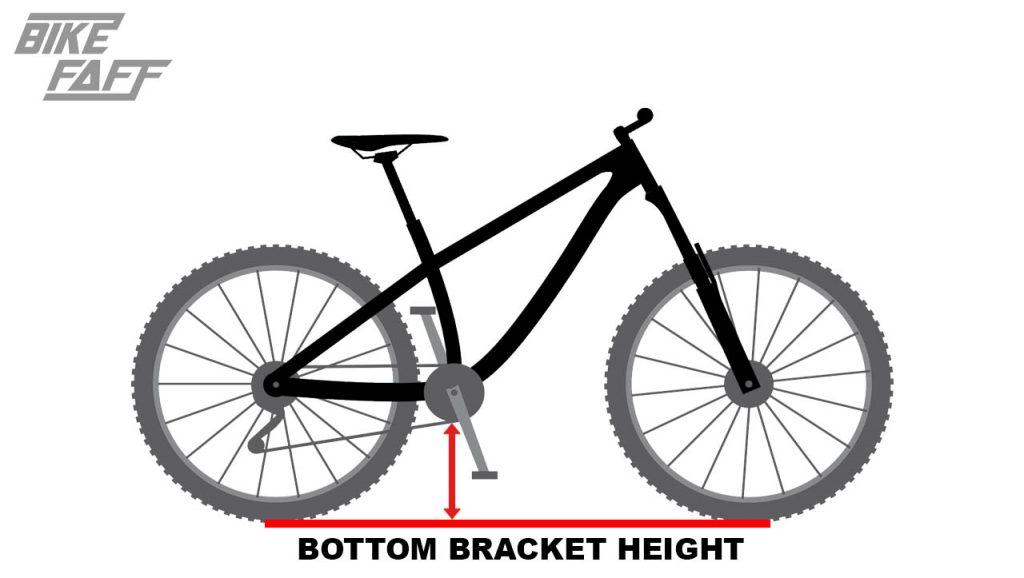
The bottom bracket height is the distance taken from the ground vertically up to the centre of the bottom bracket shell with the suspension is fully extended. This height will vary depending on the tire volume. The challenge for most mountain bike manufacturers is that a low bottom bracket helps the bike perform well, but if the bottom bracket is too low the rider will constantly catch their pedals and chainring on trail obstacles. which is why most modern mountain bikes come with shorter cranks and bash guards to protect the chainring. Bottom bracket height is not always a fixed variable, as it can change depending on; fork axle to crown length changes, tire volume changes, flip chips, mixed wheels, offset headsets, and rear shock length.
| AVERAGE BOTTOM BRACKET HEIGHT BY BIKE TYPE | S | M | L | XL |
| XC BIKES | 339 | 339 | 339 | 339 |
| ENDURO BIKES | 349 | 349 | 349 | 349 |
| DH BIKES | 352 | 352 | 352 | 352 |

Bottom Bracket Drop
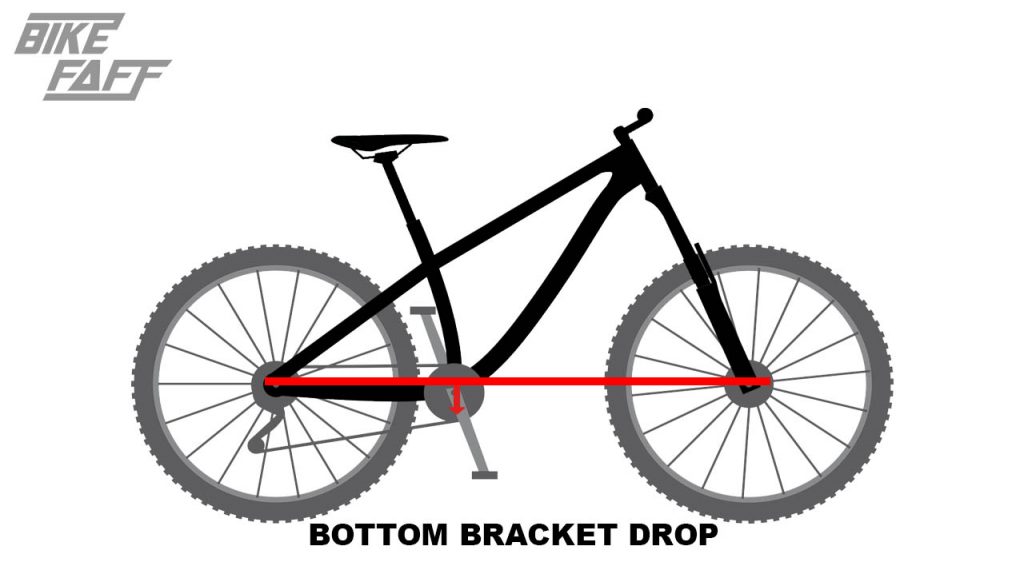
The bottom bracket drop is measured from a horizontal line between the centre of the two hubs to a vertical line up to the bottom bracket. The advantage to the bottom bracket sitting low between the axles is it gives the bike more of a planted, confidence-inspiring ride - allowing the rider to feel more connected to the bike rather than feeling like they are sitting on top like a passenger.
| AVERAGE BOTTOM BRACKET DROP BY BIKE TYPE (MM) | S | M | L | XL |
| XC BIKES | 37 | 37 | 37 | 37 |
| ENDURO BIKES | 27 | 27 | 27 | 27 |
| DH BIKES | 8 | 8 | 8 | 8 |
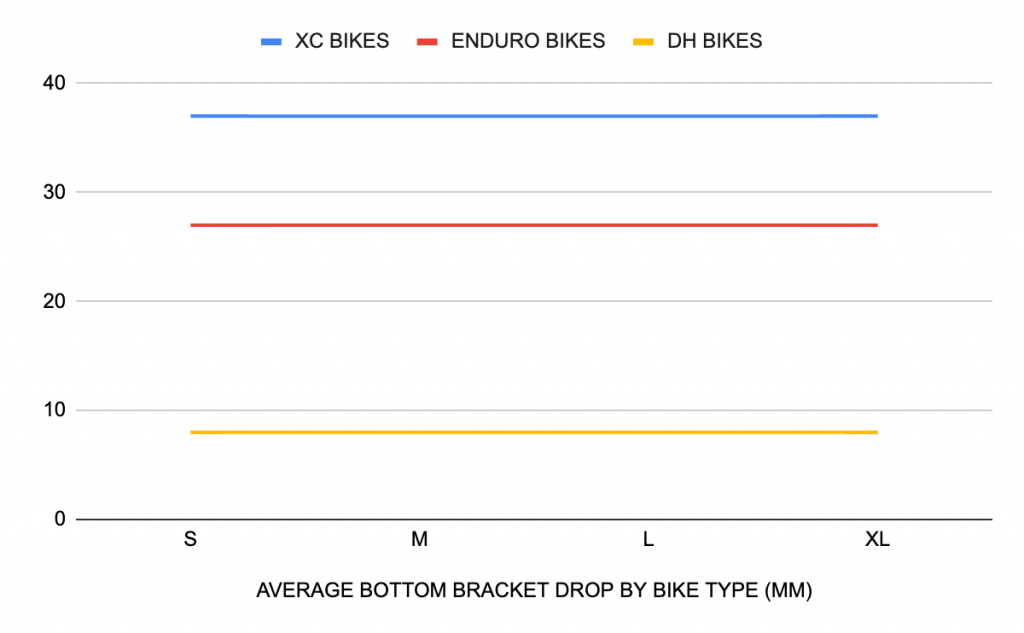
Wheelbase
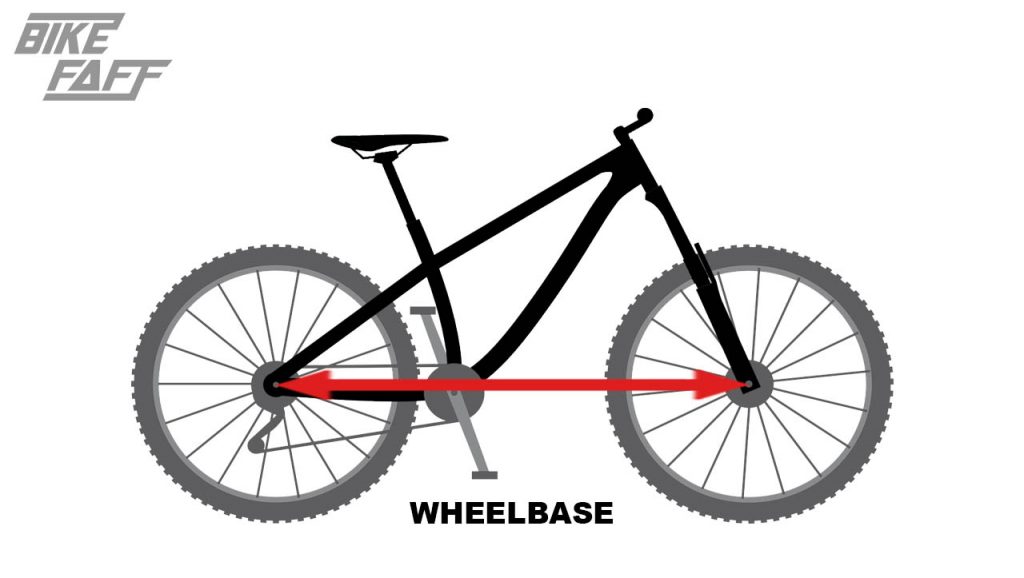
The wheelbase is the distance measured between the front and rear axles of a bike. Generally, a longer wheelbase makes the bike more stable over rough terrain, whereas a shorter wheelbase makes the bike more manoeuvrable. If you alter the head angle with an angleset or change fork length this will also affect the wheelbase. To learn more about wheelbase we have an in-depth post here.
| Average wheelbase (by mountain bike type) (mm) | Size Small | Size Medium | Size Large |
| XC | 1117 | 1149 | 1179 |
| Enduro | 1216 | 1245 | 1272 |
| Downhill | 1250 | 1269 | 1292 |
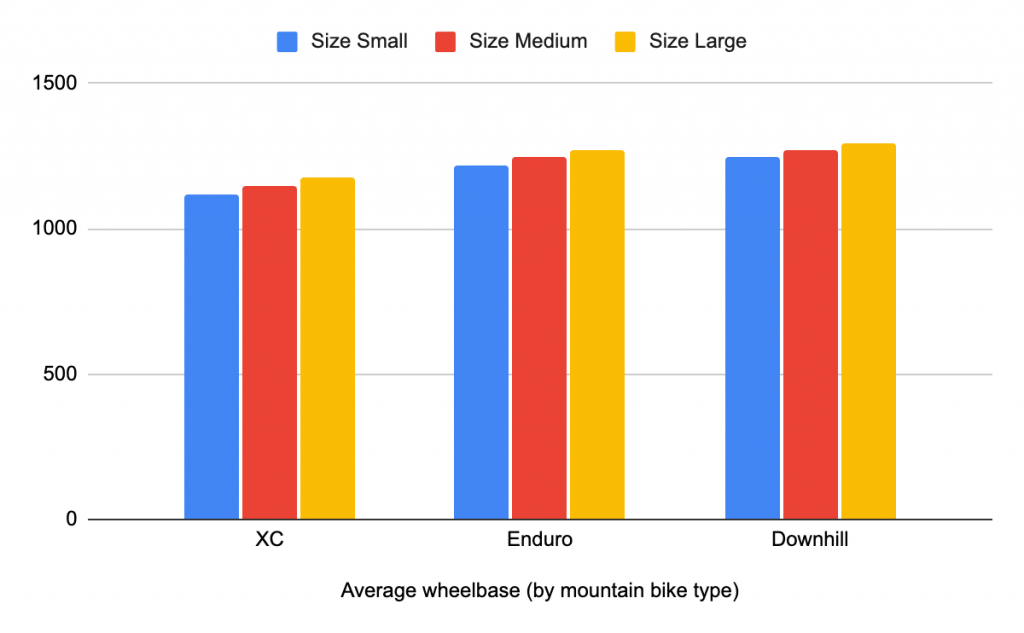
Seat Tube Angle
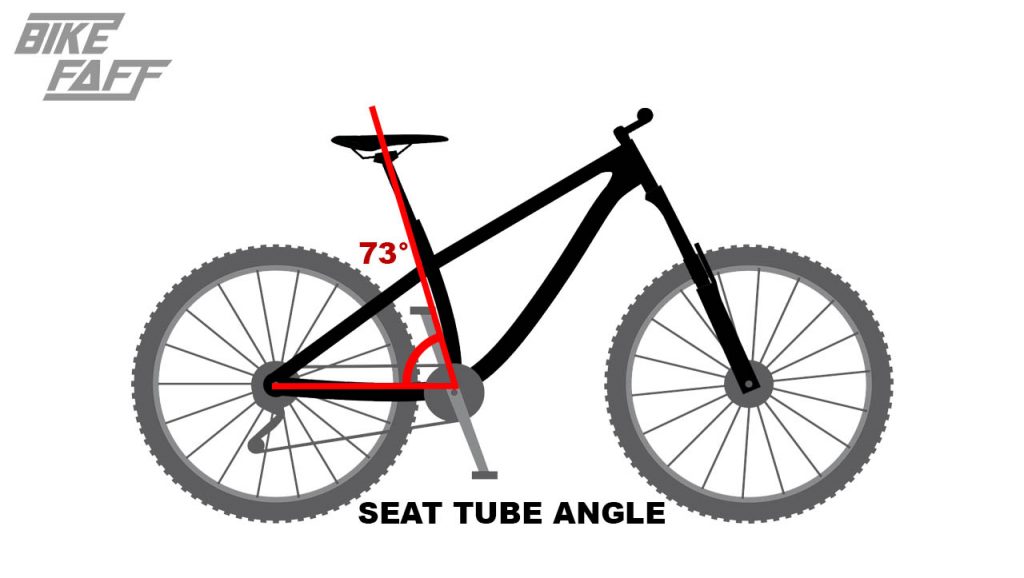
The seat tube angle is the angle of the seat tube in relation to the ground, intersecting at the bottom bracket. Most modern mountain bikes have an 'actual seat tube angle' which means that it does not intersect at the bottom bracket often due to suspension design. Seat tube angle normally ranges from 64°-78° degrees depending on what the frame is intended for. There is a trend toward mountain bike brands choosing to use steeper seat tube angles due to the benefit of improved pedalling efficiency for climbing and sprinting - due to seat tube angle affecting the position of your saddle in relation to the top of your pedals (which has a massive effect on how you pedal. Often bikes like downhill bikes have a slacker seat tube angle which makes the cockpit feel more stretched out which can be more comfortable for descending.
| Average Seat Tube Angle (by mountain bike type) | Size Small | Size Medium | Size Large |
| XC | 74 | 74 | 74 |
| Enduro | 76 | 76 | 76 |
| Downhill | 66 | 66 | 66 |
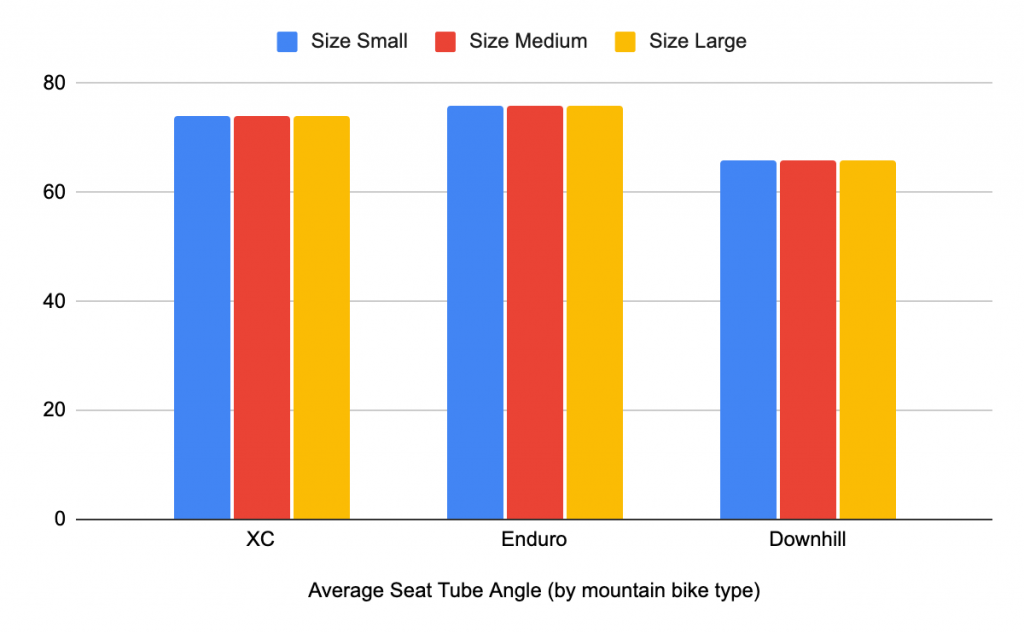
Chainstay Length
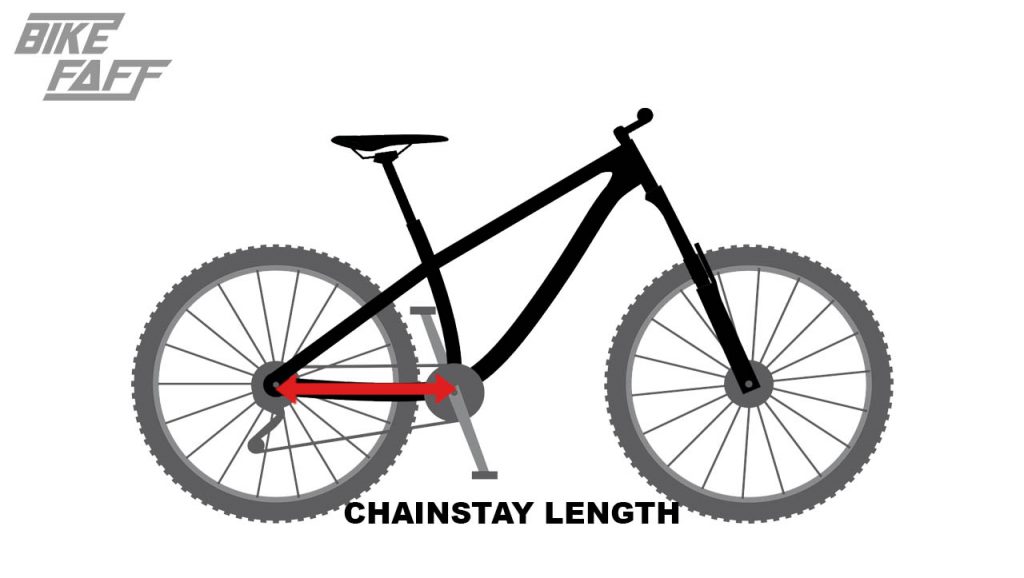
The chainstay length is measured from the bottom bracket to the centre of the axle on the rear wheel. Frames with a short chainstay length help the rider position their weight towards the rear of the bike giving a more aggressive position on the bike. Also, shorter chainstays improve responsiveness, improve frame stiffness, and make it easier to lift the front wheel. Longer chainstays help shift the rider's weight forward and make the handling more stable. Chainstay length often depends on the intended discipline, dirt jump bikes and mountain bikes often have very short chainstays to make them easy to pull up for jumping, whereas downhill bikes often have very long chainstays to help them feel more stable when riding fast downhill. Also, it's worth noting that many modern mountain bikes have adjustable chainstay length, which can help you find you're own preference or adjust it for different tracks. What is a Chainstay on a Bike?
| Average chainstay length In mm (by mountain bike type) | Size Small | Size Medium | Size Large |
| XC | 438 | 438 | 438 |
| Enduro | 442 | 442 | 442 |
| Downhill | 447 | 447 | 447 |
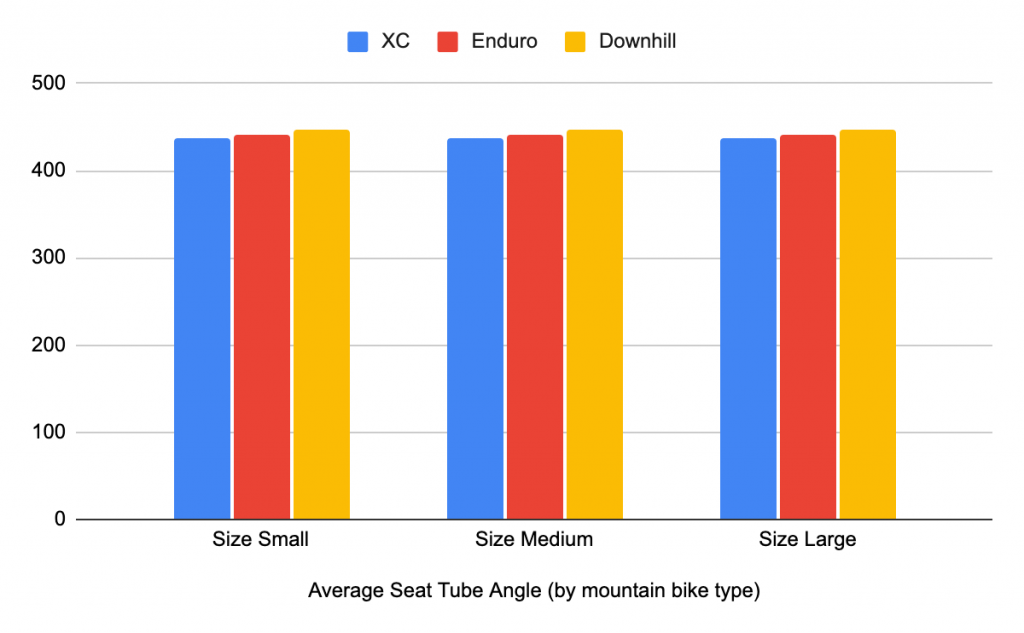
Stack

Stack is measured from the bottom bracket vertically up to the centre of the headtube. Stack is a useful measurement as it takes both the fork height and bottom bracket height into account for pedalling position, whereas looking at the headtube length alone does not. The stack height will give you a starting point of how high you can run your handlebars before you start adding or removing headset spacers.
| Average height In mm (by mountain bike type) | Size Small | Size Medium | Size Large |
| XC | 593 | 597 | 611 |
| Enduro | 616 | 620 | 629 |
| Downhill | 622 | 622 | 631 |
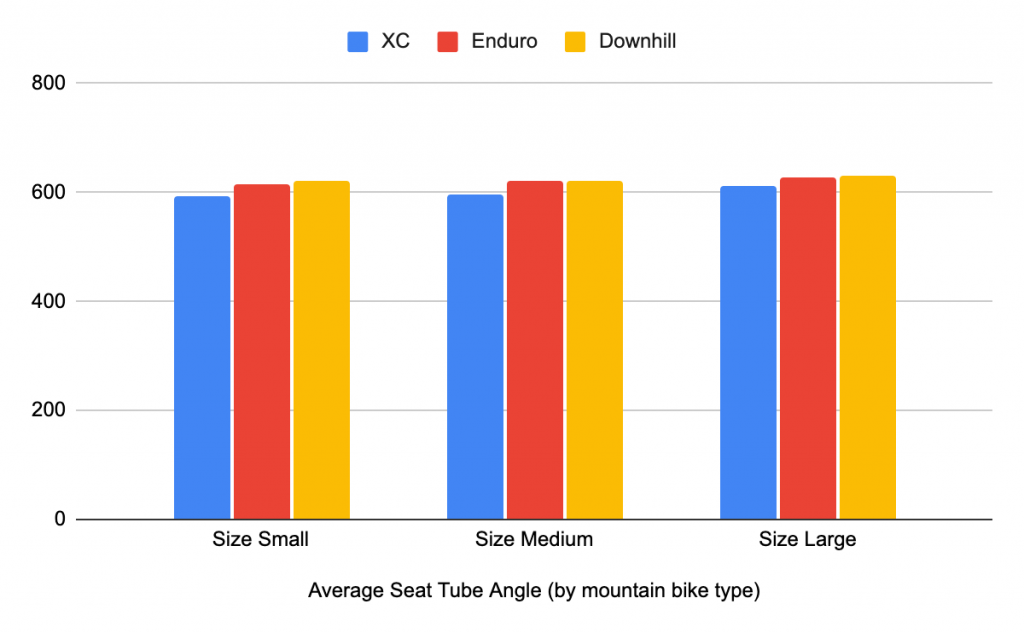
Head (Tube) Angle
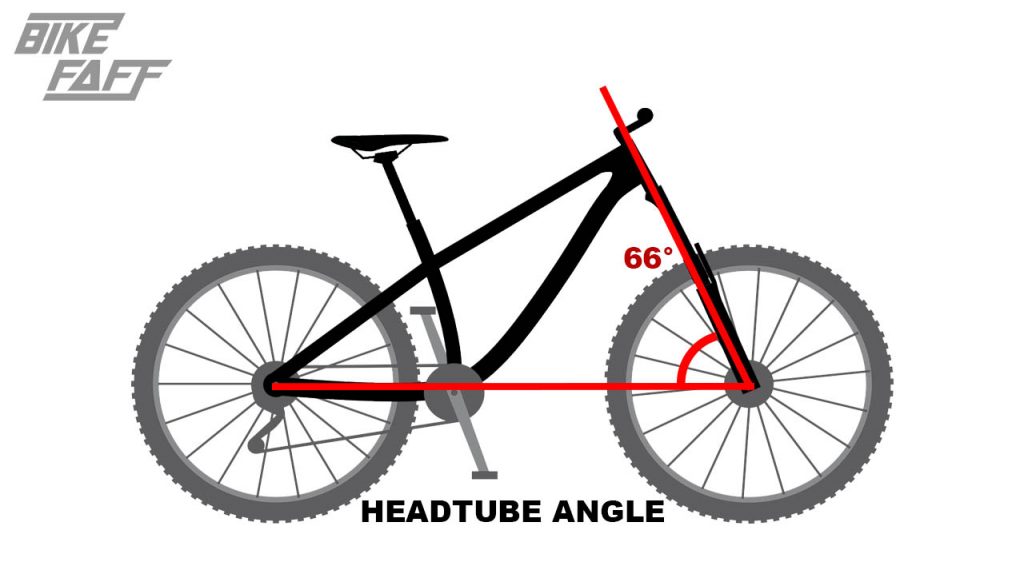
The head angle is the angle measured between the horizontal ground and the front forks. The head angle will help you predict how the front end of the bike will behave, a steep head angle will make the bike feel agile on flat slow terrain, whereas a slack head angle will make the bike feel more stable but can make the steering a little more sluggish. Generally, the more aggressive the bike is designed for the slacker the head angle. A slack head angle will range from around 59 to 66 degrees, and a steep head angle will range from around 67 to 72+ degrees. It's also worth noting that head angle can be adjusted with an angleset headset or offset bushings however this will often affect the rest of the frame's geometry, like bottom bracket height and wheelbase length.
| Average head angle (by mountain bike type) | Size Small | Size Medium | Size Large |
| XC | 68 | 68 | 68 |
| Enduro | 64 | 64 | 64 |
| Downhill | 63 | 63 | 63 |
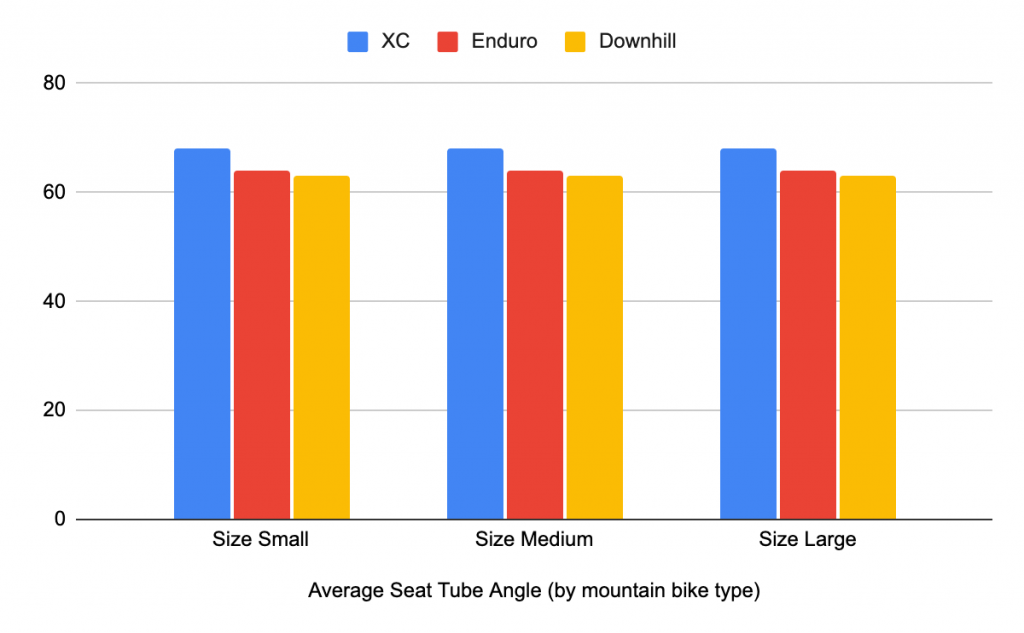
Conclusion
There are many factors to consider when looking at frame size. If you just want to keep things simple we would recommend using our mountain bike frame size calculator and finding a demo day to test your dream bike. Remember, many people are in-between frame sizes, the smaller size will be more manoeuvrable, and less stable at speed, and the larger size will be more stable, but harder to control on tight technical trails. If you are a complete novice we would recommend the smaller of the two options, as it can be more confidence-inspiring.
You may also like:

